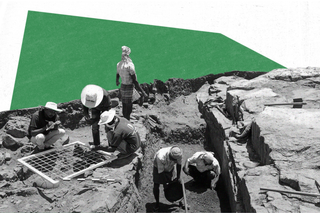
Evidence of a 3,200‑Year‑Old Tamil Nadu Civilization Counters Nationalism Myths
The findings refute the idea that the Indus Valley Civilization was the only advanced city society in India during that period.

A pot of rice and soil from the banks of the Thamirabarani river could change narratives of Indian history as we know it. Carbon dating of the sample has put its origins at about 3,200 years ago — suggesting that a Tamil Nadu civilization existed alongside the Indus Valley Civilization (IVC). The findings challenge the notion that Indian city civilizations first began with the IVC and developed along the Gangetic plains. Such notions have fed nationalism narratives, which could now be refuted.
This is not the first evidence of an advanced ancient southern Indian civilization. A dig in the quiet village of Keezhadi, near Madurai, unearthed evidence of civilization around the same time period as Gangetic civilizations. Historians classify ancient history into “phases” of urbanization. The IVC is the “first urbanization phase,” and evidence of town life near the Gangetic basin constitutes the second. The consensus was that Tamil civilization began during about the third or fourth phases.
The Keezhadi excavation and now, the Thamirabarani river artifact, push the date significantly back. The implications are significant; the culture wars over the story of India’s origins could see a paradigm shift.
“Evidence indicated similarities between graffiti found in Keezhadi and symbols associated with the IVC. It bolstered the arguments of dissidents from the dominant North Indian imagination, who have argued for years that their ancestors existed contemporaneously with the IVC,” writes Sowmiya Ashok, for Fifty Two.
While the Keezhadi excavation coincides with the “second urbanization phase,” the rice and soil pot suggests that a civilization existed in the first, alongside the IVC. Indeed, an earlier study provided evidence that ancient Dravidian languages were spoken by people in the IVC.
Keezhadi artifacts further showed that extensive literacy possibly existed in Tamil Nadu 2,600 years ago — a marker of an advanced civilization.
Related on The Swaddle
In India, People Who Speak the Same Language Have Similar DNA: Study
That the evidence showed up so recently is a consequence of political investments in historical narratives. “In the north, when the Harappa and Mohenjodaro sites fell within Pakistan’s borders, a void was felt in India about losing a precious heritage. This was the reason for a spurt in in-depth archaeological research linked to river valleys such as Sindhu and Ghaghara and of the civilization that thrived along the banks of the Yamuna, the Ganga, and Narmada plains,” K Amarnath Ramakrishna, the archeologist involved in the Keezhadi dig, told Sowmiya Ashok.
Further, the story of the IVC evolved in national discourse to be hailed as the origins of everything essentially “Indian”: Sanskrit, early Vedic Hinduism, and other signifiers of nationalism today.
When the Keezhadi dig picked up steam, therefore, the Union government intervened to replace Ramakrishna as the overseeing archeologist, and ultimately declared that nothing of note was found at the site.
“The material found in Keezhadi provides undeniable evidence of secular culture in South India. This is completely at odds with the BJP government’s Hindutva agenda and they will take every measure to ensure further research is not done in these sites,” V Arasu, former HOD of Tamil Literature at the University of Madras, told The News Minute.
Because of what such findings represent, the newly elected Chief Minister of Tamil Nadu has been quick to declare a 3,200-year-old discovery as a Tamil Nadu civilization. On Thursday, he announced the establishment of a Porunai Museum in Tirunelveli, where the artifact was discovered. “The finding has established that the Porunai river [Thamirabarani] civilization dates back to 3,200 years. It is the government’s task to scientifically prove that the history of the Indian subcontinent should begin from the Tamil landscape,” he said, in a statement.
Perhaps because of the political moment, the finding has quickly turned into the centerpiece for countering not only Hindu nationalist narratives but also the much older Northern hegemony over Indian identity. It, therefore, has the potential to turn into an instrument for Tamil nationalism in the subcontinent. The good news, however, is that it has prompted research in Egypt, Oman, Thailand, and other countries with which Tamil societies have been speculated to have traded and communicated.
The new flurry of research centered around the Thoothukudi pot thus represents an important shift away from dominant conceptions of history and Indian identity. By expanding the scope of previous archeological research, the pot could pave the way in discovering several more connections between the IVC and the subcontinent.
“With this, we could probably establish a cross-link between the Indus Valley and Tamil civilization, and probably prove that the Tamil people lived in both places and had extensive trade links in both places,” Nadika Nadja, a history enthusiast, told The News Minute.
If anything, the discovery of interconnectedness has a lot more to say about the cultural syncretism, rather than factionalism, that characterizes the history and spirit of India.
Rohitha Naraharisetty is a Senior Associate Editor at The Swaddle. She writes about the intersection of gender, caste, social movements, and pop culture. She can be found on Instagram at @rohitha_97 or on Twitter at @romimacaronii.
Related


India Has Three New Heatwave Hotspots, Raising Mortality Risks
